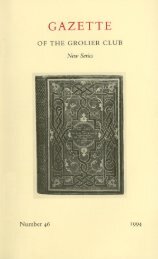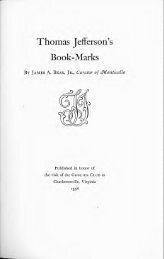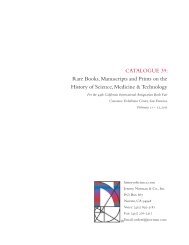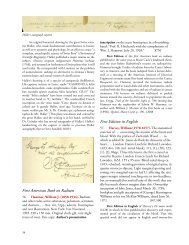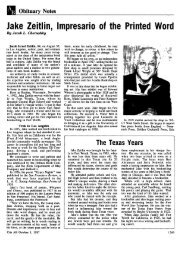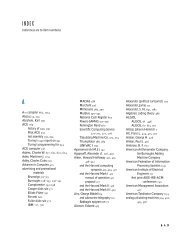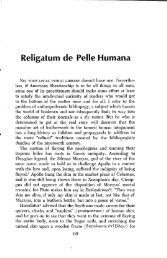Catalogue 38, Part 3 - Jeremy Norman's HistoryofScience.com
Catalogue 38, Part 3 - Jeremy Norman's HistoryofScience.com
Catalogue 38, Part 3 - Jeremy Norman's HistoryofScience.com
You also want an ePaper? Increase the reach of your titles
YUMPU automatically turns print PDFs into web optimized ePapers that Google loves.
Miller’s sanatorium by Thomas Wightman (fl.<br />
1811) after I. R. [i.e., John Ritto] Penniman<br />
(1782-1841). N.p., n.d. [before 1884]. 173 x 210<br />
mm. Laminated on paper, some marginal spotting,<br />
moderate toning. $1250<br />
Probably Unique American Medical Broadside<br />
advertising Dr. Miller’s sanatorium, located in Franklin,<br />
Mass., about 20 miles southwest of Boston.<br />
According to the advertisement, Dr. Miller’s establishment<br />
treated “persons labouring under the Cancer,<br />
Stone in the Bladder, Cataract and other diseases of the<br />
Eye, Hydrocele, White Swellings, swelled Legs, Fistula,<br />
Polypus, Hare Lips, Wens, Eruptions of the Skin and<br />
Ulcerations in general.” The advertisement further<br />
states that “much pains have been taken to make this a<br />
place of resort, where Invalids will receive every attention,<br />
which may render their situation <strong>com</strong>fortable &<br />
pleasant. Ladies will find suitable ac<strong>com</strong>modations.”<br />
The illustration of Miller’s sanatorium that heads the<br />
circular was drawn by John Ritto Penniman, described<br />
as “perhaps the most skilled, inventive and versatile<br />
ornamental artist and draftsman of his time in America”<br />
(Antiques Magazine, July 1981). Penniman was<br />
also one of American’s first lithographers, credited for<br />
making the first drawing on stone ever done in the<br />
United States (Zellman, 300 Years of American Art, p.<br />
94). An inscription on the back of the circular, partially<br />
obscured by the lamination, is dated Feb. 2, 1884.<br />
Benezit. <strong>38</strong>080<br />
Inscribed by William T. G. Morton<br />
80. [Morton, William T. G. (1819-68).] Rice,<br />
Nathan Payson (1829- ). Trials of a public benefactor,<br />
as illustrated in the discovery of etherization.<br />
[2], xx, [13], 14-460pp. Engraved<br />
frontispiece, 3 plates. New York: Pudney & Russell,<br />
1859. 185 x 124 mm. Original blind-stamped<br />
brown cloth, gilt-lettered spine, front hinge<br />
slightly cracked, extremities and corners slightly<br />
worn, but very good. Presentation copy, inscribed<br />
by Morton on the front free endpaper: “Dr.<br />
Sabine with respects of Wm. T. G. Morton.”<br />
$7500<br />
First Published Edition. The first—and until<br />
recently the only—full-length biography of William T.<br />
G. Morton, the Boston dentist who in 1846 demonstrated<br />
to the medical profession the efficacy of sulfuric<br />
ether as a general surgical anesthetic. Morton was not<br />
himself responsible for the discovery of ether’s anesthetic<br />
properties, which he had learned of from Charles<br />
T. Jackson, but he lost no time in attempting to profit<br />
from ether anesthesia, first by patenting it (in conjunction<br />
with Jackson), and then, when the patent proved<br />
ineffective, by playing up his role in the discovery and<br />
petitioning Congress and other institutions for large<br />
cash awards. Morton’s relentless opportunism provoked<br />
what is now known as the “ether controversy,” a<br />
long-running battle between Morton, Jackson and others<br />
over who deserved credit for the discovery of surgical<br />
anesthesia.<br />
As part of his ongoing campaign to promote his claim<br />
to priority, Morton hired Nathan Rice, a young physician,<br />
to “write for him [Morton] a sketch of his life &<br />
history of the discovery of etherization he to furnish all<br />
of the materials & be responsible for all the statements<br />
personal and otherwise” (quoted in Wolfe, p. 407).<br />
Completed in three months, Trials of a Public Benefactor<br />
unsurprisingly presented Morton as the hero of the<br />
anesthesia story. The book was first issued in October<br />
1858 in an unillustrated advance “press copy” edition<br />
with title-page dated 1858. The published edition,<br />
with the date changed to 1859 and quotations from<br />
Shakespeare and Burns added to the title, appeared a<br />
few months later. Morton’s questionable dealings with<br />
74



